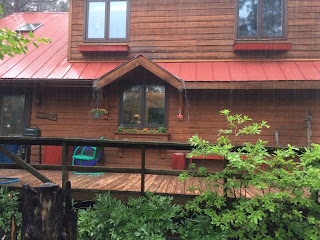Rain threatens birds
WINGIN’
IT
By
Kate Crowley
As the floodwaters
recede, a stunned and relieved populace can finally stop holding their
collective breath. Throughout southern Carlton County and all of Pine County
there is a sense of disbelief that only four years after a major flood event,
it has happened again. At our home we
measured over 8” of rain in less than 24 hours. This is what the word deluge
was meant to describe. Others said it felt like they were in the middle of a
monsoon.
Thankfully there was no
loss of life in our region, but property damage and loss was significant for
people who have in some cases finally recovered and remodeled after the flood
of 2012, which was said to be a once in 100 years flood when 8 to 10 inches of
rain were spread over three days.
Here in Willow River,
there was fear that the small dam holding back the waters of the river would
fail, with catastrophic results. Roads throughout the two counties (and into
Wisconsin) were hard hit and the cost to repair them is going to be far beyond
what has been budgeted for maintenance.
We are living in a time
when the rules are changing, along with the climate and it is going to require
a lot of thoughtful planning and sometimes painful choices to adapt to this new
reality. I can only imagine the anxiety people living along one of our rivers
or near Moosehead Lake will feel when future storms come through. But as humans we have a range of options when
it comes to adapting to our surroundings; wildlife on the other hand are far
more limited.
When we are in the
middle of an emergency like this most recent storm, our thoughts are focused on
the people who we may or may not know that are suffering. Once the immediate
threat is past, we have time to look around and assess the damage and its potential
effect on other life forms.
This most recent storm
came at a time when most of the songbirds have finished nesting, but just
barely. It is in early July that young
fledglings are seen following their parents around and begging to be fed, even as
they have the means to fly and hopefully feed themselves. The woods are full of these inexperienced,
still dependent young. Around our home
during that day of downpours, we thought a lot about the birds and how they
were sheltering from the nonstop rain. Water poured off our eaves making
waterfalls that the hummingbirds had to fly through to get to their feeders.
The other feeders in the yard were devoid of activity, except when there was a
lull in the rain and then birds mobbed them, trying to gulp some seeds down
while they could. The rest of the time
we imagine they were hunkered down in some foliage, with feathers fluffed up,
trying their best to keep their bodies warm and dry.
For those birds that
might have still been incubating eggs or feeding nestlings, the ground nesters
would have been most threatened. I
didn’t realize how many this would include until I looked them up and for our
area. They include the following; Brown
Thrasher, Veery, Black-and-White warbler,
Golden-winged warbler, Nashville warbler, Palm warbler, Northern Waterthrush,
Mourning warbler, Wilson’s warbler, Ovenbird, Canada warbler, Wilson's warbler,
Eastern Towhee, Vesper sparrow, Lincoln’s sparrow, and Song sparrow. Even in
areas that didn’t flood, this would have been a very challenging time. In the cattail marshes where the waters rose
Red-winged blackbirds and the Sedge and Marsh Wrens would have suffered losses.
Since we will never
know the actual outcome for these many bird species, we can only hope they
survived and will return next year to try again. It is probably too late in the season for
most of these species to re-nest.
As for the forests and
wetlands impacted by this most recent flood, they will recover and may provide
new habitat for birds in the future.
After the 2012 flood, many people moved away from floodplains creating
more habitat for wildlife. Ducks, herons
and other wading birds may find more areas to forage for fish and
invertebrates. In the long run, it is
not floods such as this one that have the greatest negative impact on the birds;
it is deforestation and the use of chemicals in the environment that will
really determine their long term survival.
As we reluctantly learn
to live with this new weather paradigm, we can help ourselves and all wildlife
by restoring wetlands and protecting wider stream corridors, thus reducing
flood impacts for humans, improving water quality and creating better and more
wildlife habitat.





And, in the long run, it is deforestation and the use of chemicals in the environment that will really determine OUR long-term survival.
ReplyDelete